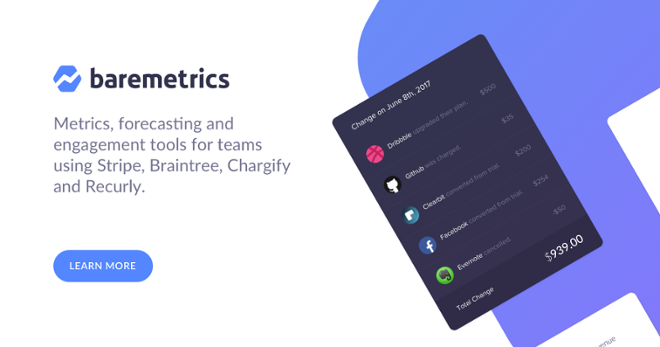From tiny startup to multi-national scale-up, growing a SaaS company is a rollercoaster ride of ever-evolving challenges.
Crossing the chasm is one of the biggest challenges you'll take on, a huge hurdle that's claimed thousands of promising startups.
So to help you understand it, and avoid common pitfalls when the time comes, we've pulled together a complete, all-in-one guide to scaling a SaaS company - with actionable tips for selling to every type of buyer you'll encounter on your journey to scale.
What is the Chasm?
If you're building a SaaS company, you might be familiar with the technology adoption life cycle.
Based on the classic bell curve distribution, it's a tool for visualising the adoption of a new technology over time: starting with a small handful of early adopters, moving through the massive mid-market, to eventually find its way into the hands of even the most change-resistant consumers.
The technology adoption lifecycle is broken down into 5 key segments:
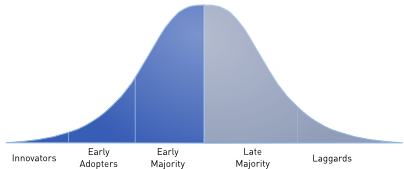
First to adopt the new technology are innovators, followed by the early adopters and the early majority (together making up the early market); later come the late majority, and finally, somewhat reluctantly, the laggards.
But, as hundreds of SaaS founders have discovered (often to their chagrin), there's a big problem with the classic technology adoption lifecycle.
The Chasm
If I had to pick-out a reading list for SaaS founders (and I did), Crossing the Chasm by Geoffrey Moore would sit right near the top.
Containing the benefits of a few decades' worth of dedication to studying the technology adoption life cycle, it's a goldmine for working out exactly what makes people buy new technology.
The biggest learning to be taken away from the book: the technology adoption life cycle is flawed.
Rather than being a completely uniform curve, with product adoption smoothly progressing through the different market segments, there are actually big gaps where fledgling startups can fall flat - finding themselves unable to appeal to the next market segment.
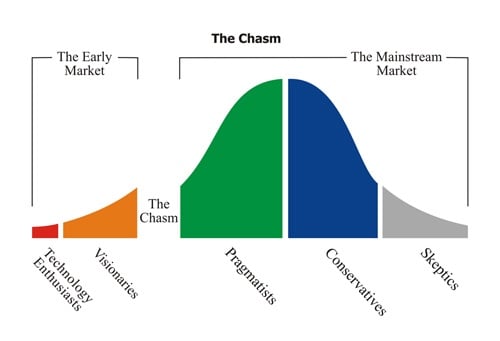
The cause of these "gaps" is simple: each segment of the market is looking for something different when they buy technology. The bigger the difference in the motivations, the bigger the gap.
The Five Adoption Gaps
1) Technology Enthusiasts
Look to get the latest technology first, and less concerned with functionality and benefit.2) Visionaries
See the potential for exponential benefit made possible by the new technology, and want to have influence in shaping the technology to fulfill their vision.3) Pragmatists
Only buy technology when there's a proven benefit to using it.4) Conservatives
Only buy technology when they'll experience a loss by not adopting the product.5) Skeptics
Only buy technology when it's forced upon them.Crossing the Chasm
When you read those descriptions, it becomes clear that the biggest gap (or the chasm) is found between the visionaries and the pragmatists.
This gap presents a huge challenge to SaaS companies like yours: how do you go from selling to the visionaries - people happy with an unfinished products full of potential - to the pragmatists, people fixated with the concrete, proven benefits of implementation?
How can you cross the chasm?
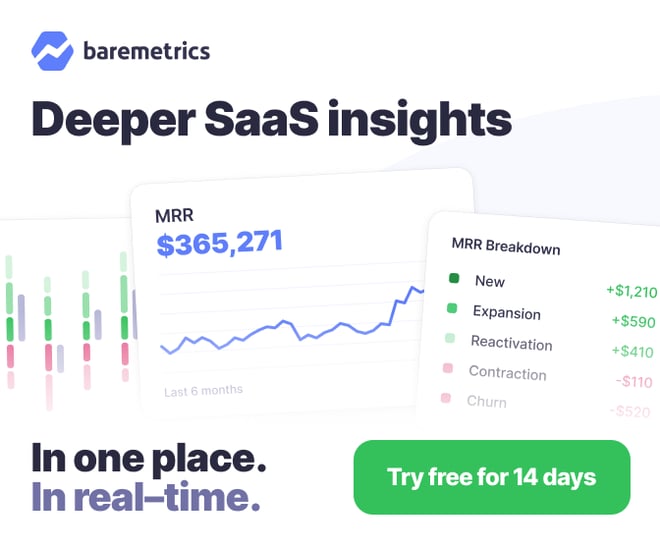
Technology Enthusiasts
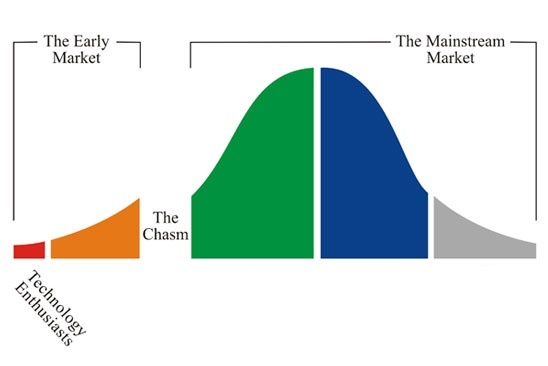
On the long road to success, your new SaaS product has to go through several stages of growth, and attract a multitude of different buyers.
If we look at the Technology Adoption Lifecycle, technology enthusiasts represent the first hurdle you'll come to; and successfully developing, growing and scaling your product will require you to understand (and effectively sell to) these crucial buyers.
Today, I'm exploring this enigmatic group of potential customers - and helping you to understand exactly how to sell your SaaS product to technology enthusiasts.
Who are Technology Enthusiasts?
Technology enthusiasts represent the very first people to adopt your product. They’re the buyers that take risks on young, unproven SaaS ventures; adopting new (and often unfinished) products that lack a defined business case or a proven track record.
They have a very high tolerance for risk, often adopting SaaS products which later go on to fail. Particularly with enterprise buyers, these costs of failure are often offset by significant financial resources, allowing technology enthusiasts to adopt multiple early-stage products.

Whilst tech enthusiasts are typically willing to pay for your product, the revenue they provide won’t be anywhere near as significant as revenue gained from later adoption stages.
Tech enthusiasts represent the smallest segment of the product adoption lifecycle (estimated at about 2.5% of the total market for your product); and crucially, view themselves as active participants in the product development process. They’ll provide feedback and insight into the functionality of your product, but they’ll be less willing to contribute revenue as a result.
What do Technology Enthusiasts Care About?
Technology enthusiasts represent a unique part of the technology adoption lifecycle, with their buying decisions almost completely devoid of traditional business motivation.
Instead of purchasing your SaaS product because of its track record, established case studies and proven ROI, they’ll adopt your product because of its unique status as new and innovative.
They’re the people that love technology for technology’s sake.
They’ll use unfinished software, and put up with bugs and glitches, simply because they value being the first to use a new product. They’ll understand why you don’t have any case studies, or user testimonials – and instead of being alienated by a lack of conventional social proof, they’ll be motivated by it.
In many cases, their adventurous buying decisions are amplified by their professional reputation. It may be that introducing new technology is a key part of their role, or that their colleagues and clients expect them to be at the cutting-edge of industry innovation.
In these instances, tech enthusiasts benefit from new products through the sheer virtue of them being new – without any need for more tangible business benefits.
How to Sell to Technology Enthusiasts
In order to sell to technology enthusiasts, it’s essential to identify their pain points, and develop marketing strategies to systematically address them.
1) RECOGNISE THEIR IMPORTANCE
Tech enthusiasts are unlikely to contribute a vast amount of revenue, but they’re crucial from a product development standpoint. Think of them as paying beta testers, helping you to refine and shape the direction of your product, ready for the visionaries, pragmatists and beyond.
2) FOCUS ON TECHNOLOGY, NOT JUST BUSINESS
As an early-stage product, you won’t have a proven business case. Thankfully, this isn't necessarily a deal-breaker for most technology enthusiasts. These buyers don’t fixate solely on the business case, and care as much about the technology's potential as they do for it's proven track record.
Whilst it's always helpful to highlight the potential business case of your product, it's just as important to focus on the technology of your SaaS product – highlighting its innovations, and potential to disrupt.
3) THINK TO THE FUTURE
Part of the appeal of new technology is its implications for future technology. Whilst tech enthusiasts don’t buy because of their belief in future performance or monetary gain, they’re likely to believe that your product is the first in a long-line of new technologies - so it's important to be explicit about your vision for future technology and product innovation.
4) APPEAL TO THEIR EGOS
It’s important to appeal to a tech enthusiast’s experience, and ask for their insight and help in developing your product. Talk to them as more than just customers – they’re almost investors, helping you to shape the product, as well as use it.
5) HARNESS THE POWER OF URGENCY
Tech enthusiasts gain benefit from being the first to adopt a new product. To capitalise on that motivation, you need to highlight the fact that your product is new to the market, and in an early stage of development – and emphasise that, by buying now, their input will have a real impact on the product's development.
If you’re feeling particularly adventurous, you can even ask potential buyers to request early access, adding a sense of exclusivity to their purchase.
Visionaries
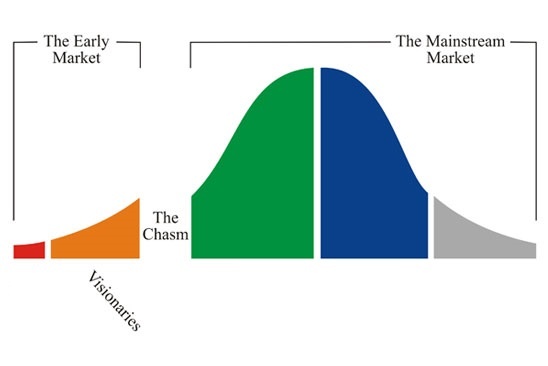
In order to reach the mainstream market, your SaaS product has to find its way into the hands (and hearts) of two different types of buyer.
We’ve already looked at technology enthusiasts, and discovered how to leverage their passions and pain points to sell your product; and now, we need to look at the other half of this crucial early stage market: visionaries.
Who are Visionaries?
Visionaries, along with technology enthusiasts, form the first segment of the technology adoption lifecycle, known as the early market.
Together, these two types of consumer play an essential role in growing your business, with each willing to adopt your product with little in the way of social proof or a proven track record.
Despite their shared tendency to take risks on new products, these two types of buyers have little else in common.
Tech enthusiasts are driven by the potential of the technology behind your product, deriving benefit through the sheer virtue of being new and innovative. In contrast, visionaries are interested in its potential use case, and seek out the products that offer the biggest scope for business benefit.

Visionaries have a dream for their business, and for your product. They have a strong idea of what they want your product to be, and will often want to influence the development of your product to bring it in line with their own vision.
This can be hugely useful for the ongoing development and refinement of your offering, but crucially, the input of visionaries can be less grounded and feasible than that of tech enthusiasts.
Whilst tech enthusiasts provide your business with its first tentative cash inflows, visionaries offer a chance to significantly increase your revenue. Visionaries make up a much larger part of your total market than technology enthusiasts (13.5% compared to 2.5%), and are typically willing to spend much more on your product.
This is borne from their belief in the potential of your product, allowing visionaries to justify large investments in pursuit of even larger returns.
What do Visionaries Care About?
Visionaries are the people that want to earn recognition for making massive changes within their organisation, and use that kudos to springboard to a more senior role.
Whilst the allure of improving the productivity and efficiency of their business is still important, it’s the products that promise to revolutionise their business that prove most attractive.
As a result of this, the promise of a good, but not exceptional, return may not be enough to bring visionaries on board.
Visionaries are often guilty of harbouring unrealistic aspirations and goals; and whilst they won’t expect all of their investments to realise these goals, they’ll look for products that are obviously setting out to achieve big things.
A SaaS product that errs on the side of caution, and promotes itself in a distinctly modest way, may not do enough to attract these types of buyers.
Instead of being relatively unconcerned about the potential business case of your product (like tech enthusiasts), visionaries are almost hyper concerned, seeking out promises of exponential returns and massive growth.
Whereas tech enthusiasts care more about the product’s technology than its potential business case, visionaries are motivated by the potential business rewards, and care little for the technology that enables it.
How to Sell to Visionaries
1) CHANGE YOUR MESSAGING
The first step in selling to visionaries is changing your messaging. With profound differences between tech enthusiasts and visionaries, the strategies you used to launch your product won’t necessarily be the right strategies to help you grow it.
As you move through the technology adoption lifecycle, you need to constantly refine and alter your messaging to appeal to different types of buyer.
2) INCREASE YOUR PRICING
Visionaries have a desire to realise incredible results, and are willing to spend money to do so. In other words, they'll be willing to bear a much higher price than tech enthusiasts were – and as long as you have the perceived potential to back it up, you’ll be best served by upping your product price.
3) DEVELOP COMPETITOR COMPARISONS
When a visionary buys your product, they’re making a declaration of their faith in your business – choosing your product, above all others, to help them realise their lofty goals. You can leverage this by creating explicit competitor comparisons, and highlighting the benefits of your product over its rivals.
Box famously leveraged this strategy when taking on established giants Sharepoint, creating a marketing campaign as effective as it was aggressive.
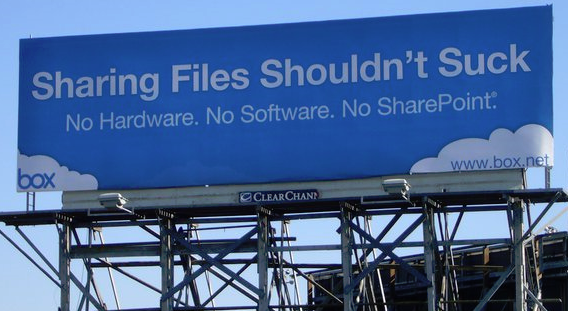
4) START PROMOTING CASE STUDIES
Case studies from early customers can provide an early form of social proof, and act as a way of reinforcing your ability to achieve incredible results.
With visionaries so concerned about the potential business case of your product, promoting an example of stellar results can be hugely powerful. Crucially though, these results need to be impressive – and promoting a mediocre case study may damage their motivation to buy.
5) UNDERSTAND THE VISION
If you want to sell to visionaries, you need to get inside their heads, and understand the dreams and ambitions that drive them to buy. The easiest way to do this is by interviewing your current customers, and creating buyer personas from their insight.
Pragmatists
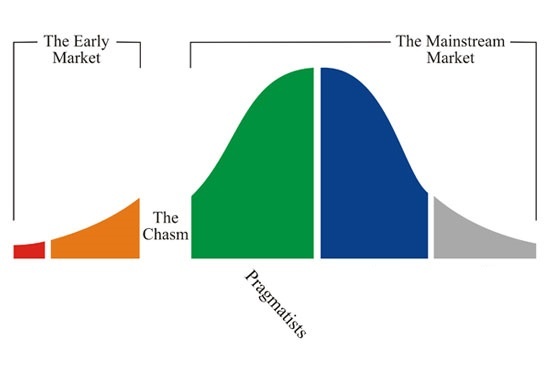
We've looked at tactics for selling your SaaS product to the early market. Now, it's time to ramp-up your sales and marketing efforts, and take-on the real money making segments - starting with pragmatists.
Who are Pragmatists?
Pragmatists represent the first segment of the mainstream market, and together with conservatives, make-up over two thirds of the entire market for your product.
Though technology enthusiasts and visionaries play an essential role in getting your product up-and-running, its the pragmatists that possess the real spending power - and their attitude to your product will play a crucial role in determining its success.
Unlike the market segments before them, pragmatists have a low tolerance for risk. They aren't looking to gamble their investment for a shot at a huge return: they're looking for a safe, predictable and achievable ROI.

Pragmatists are realists, and whilst (like visionaries) they're looking to gain an edge over their competitors, they'll look for your product to set achievable expectations. Those expectations need to be backed-up by a proven track record of performance - complete with case studies, testimonials and cold, hard data.
Thankfully, the difficulties of selling to pragmatists are offset by the benefits.
At 34%, pragmatists make up a much larger portion of your market than either visionaries (13.5%) or technology enthusiasts (2.5%). With a proven track-record behind your product, it becomes easier to justify an increase in pricing, and pave the way for more profitable sales.
Pragmatists won't look to shape your product in the same way tech enthusiasts and visionaries will. Instead, they'll look for stable functionality and proven processes.
Once they've committed to your product, their desire to get the most out of their investment will make it relatively easy to cross-sell and up-sell training and professional services.
What do Pragmatists Care About?
RISK MINIMISATION
Whilst visionaries are willing to take big risks to earn big rewards, pragmatists are defined by risk aversion. Though they're looking to earn a decent return on investment, they want to do so in a safe and predictable way.
They'll look for well-established businesses, scrutinise your predictions, and seek out testimonials and reviews. To earn their trust, and their business, it's essential to do everything possible to reduce the percieved risk of partnering with you.
VENDOR COMPETITION
In the eyes of a pragmatist, competition between vendors breeds stable, efficient businesses. Partnering with the sole business in an emerging marketplace creates unwanted risk for the pragmatist. Instead, they'll prefer to choose between multiple vendors in a competitive marketplace.
THE BUSINESS CASE
Whilst visionaries will be satisfied by a simple (and often optimistic) business case, pragmatists will want to drill-down into numbers, and assess the validity of your predictions.
Cost/benefit analysis and complex ROI calculations play a significant part of the buying process - and without data to back-up your claims, the pragmatist simply won't take the risk.
A PROVEN TRACK RECORD
Successfully partnering with other businesses demonstrates that you have the processes, resources and expertise to deliver on your promises. Pragmatists will need more than just a handful of case studies - they'll need to know that the businesses you've worked with are just like them, in terms of industry, ethos and size.
EASE OF USE
Safety, security and stability are bywords of the pragmatist. Before committing to a SaaS product, they'll need to know that they can use it in an effective way - learning about your processes for rolling-out the software, scaling its use, and training their employees to use it.
How to Sell to Pragmatists
1) HIGHLIGHT THE BUSINESS CASE
When it comes to attracting pragmatists, a solid business case is the best tool your SaaS product has in its arsenal.
Accurate performance data, realistic predictions and achievable targets will help convince pragmatists of your ability to generate the low-risk return they're looking for; and the more information you have to back-up your claims, the better.
2) DEVELOP CASE STUDIES
Whilst both visionaries and pragmatists care about case studies, they'll look for them for different reasons. Visionaries care about stellar results and exponential growth, and case studies from a handful of early adopters will help them view your product as a chance to get ahead of the curve.
In contrast, pragmatists will look for case studies that repeatedly show achievable, consistent growth, across a range of companies exactly like them.
3) PROMOTE SOCIAL PROOF
As well as case studies, other forms of social proof, like testimonials and reviews, play a powerful role in the pragmatist's buying process.
In addition to integrating relevant testimonials into key parts of your website (like landing pages and pricing pages), review sites like G2 Crowd can be used to aggregate independent reviews. If you're lacking in social proof, get in touch with your customers, and offer them small incentives for leaving fair, unbiased reviews of your product.
4) LEVERAGE THIRD-PARTY REPORTS
Pragmatists are the first market segment to place real stock in independent reports. By paying for inclusion in market research reports (like Gartner's 'Magic Quadrant'), you can increase the visibility of your product.
Though these reports can be expensive to enter, doing so can offer powerful social proof of your business' size, stability and financial security.
5) USE COMPETITOR COMPARISONS
Pragmatists are likely to shop around, and compare your product to its competitors. It's important to acknowledge this comparison, and even take ownership of it, by creating your own comparison tables and studies.
Like HubSpot do with rivals Marketo, explicit comparisons allow you to frame your product in the best way possible - highlighting the strengths of your product, and the weaknesses of your rivals'.
Conservatives
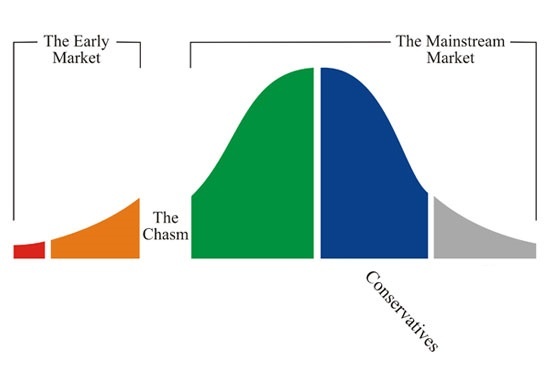
So far, we've managed to sell our SaaS product to technology enthusiasts, visionaries and pragmatists. Now, it's time to roll-up our sleeves, and take on an even bigger challenge. Today, we're learning how to sell to the pragmatist's reluctant big brother: the conservative buyer.
Who are Conservatives?
Take a look at the familar segments of the technology adoption lifecycle (above), and you'll notice that the rate of adoption has been increasing. With each transition, from tech enthusiasts to visionaries, visionaries to pragmatists, both the total number of users and the rate of growth have been increasing.
Like pragmatists before them, conservative buyers represent a huge portion of the total market for your product (roughly 34%); but crucially, they're also the first segment where the rate of adoption actually decreases. Though new users are still adopting the product, they're doing so at a slower rate.

There's are couple of reasons for this slowdown.
With half the market already saturated, it becomes harder to attract new buyers. Even then, instead of adopting technology to gain an edge over their competitors (like pragmatists), conservatives adopt technology to avoid losing marketshare.
They're a reactive market, not a proactive one; and their drive to purchase is motivated out of perceived necessity, and not a desire to improve performance.
This means that conservatives are incredibly risk averse, only willing to adopt a new technology when all those around them have already done so.
Instead of being motivated by potential performance improvements, they're driven by price: looking to adopt the same technology as their competitors at the lowest possible cost.
What do Conservatives Care About?
LOSING GROUND
Pragmatists adopt new technology to improve performance, and gain an edge over their rivals. When these performance benefits come to fruition, conservatives are forced into action; coerced into adopting the same technology as their more pragmatic rivals, to avoid being out-competed.
They aren't motivated by the benefits of using your product, or its potential to transform their business - they're simply trying to stay competitive. They aren't purchasing your product because they can see the value in it: they're purchasing it because they have to.
PRICE
Though conservatives will still weigh-up your product's business case, to some extent, the business case has already been borne out by the adoption of the technology by their rivals.
Instead, conservatives are more likely to scrutinise the price of your product, as they look to adopt the same technology as their competitors at the lowest possible cost.
Like pragmatists, conservatives would realise huge benefits from professional services, and product-related training - but with such a fixation on price, they'll be unwilling to budget resources to pay for them.
MATURE MARKETS
As the market for your technology starts to mature, and growth starts to slow, there'll be fewer new entrants into the market, and a handful of SaaS solutions will start to dominate.
These changes are hugely appealing to conservatives, as they look to choose between established vendors, and identify the most popular, trusted, and tried-and-tested solutions available.
RISK AVOIDANCE
The conservative's buying process is a reluctant one, as competitor success forces them into a purchase they wouldn't otherwise make. They're trying to protect their interests, and in doing so, they'll do everything in their power to ensure their purchase is as risk-free as possible.
How to Sell to Conservatives
1) FOCUS ON FEAR
Selling to conservatives requires a change in your marketing messaging. Instead of intensely focusing on the benefits of adopting your SaaS product, you need to emphasise the risks associated with not adopting, and play on the conservative's fear of being overtaken by their competitors.
2) PROMOTE SOCIAL PROOF
In order to encourage conservatives to buy your SaaS product, you need to highlight the fact that all of their competitors have already adopted it.
The best way to do this is to collate relevant social proof: collecting testimonials, independent reports, case studies and examples of similar businesses that are already using your SaaS product.
3) USE DISCOUNTING
With earlier segments, discounting can devalue your product, and deter the sales process: but with price such an important part of the conservative's buying process, discounting can be invaluable for attracting new buyers.
By this stage of growth, it's likely you'll have a database of inactive conservative leads - and by reaching out to them with a special offer, you can undercut other vendors and re-engage your cold contacts.
4) HIGHLIGHT COMPETITOR COMPARISONS
Conservatives will be more critical of your product, process and price than any other segment before them.
With an increasingly mature marketplace of other vendors to compete with, it needs to be easy for potential customers to compare the features of your product with those of its competitors: allowing conservative buyers to weigh up every line item, and justify each penny of their investment.
5) STABILISE YOUR PRODUCT
Technology enthusiasts and visionaries need to be active participants in the product design process, but at this stage of the market, your product needs to be in a stable, finished form.
Any drastic functionality changes or dramatic redesigns will put the frighteners on a conservative buyer, introducing unknown variables and potential risk - enough to halt a conservative sales process in its tracks.
Skeptics
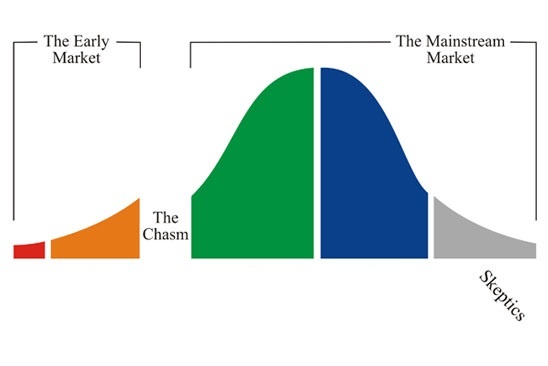
From technology enthusiasts through to conservatives, we've learned how to sell our SaaS product to each crucial stage of the technology adoption lifecycle. Now, there's only one hurdle standing in the way of total market saturation: skeptics.
Who are Skeptics?
Any type of new technology has a long journey ahead of it.
Before it can gain public acceptance and widespread appeal, it has to progress through several stages of market adoption.
At each stage of adoption, your SaaS product has to appeal to a unique subset of buyer, and it becomes necessary to re-frame your sales and marketing efforts to appeal to their unique motivations:
- Technology enthusiasts adopt new technology for technology's sake.
- Visionaries adopt to realise tranformative performance improvement.
- Pragmatists adopt to gain an edge over their competitors.
- Conservatives adopt to avoid losing out to their competitors.
Skeptics represent the final barrier to total market saturation; and like the segments before them, skeptical buyers will approach your product with a unique set of motivations and needs.
Unfortunately, those motivations and needs boil down to a single statement of fact: skeptics hate your SaaS product.

While the early market is characterised by a desire for change, innovation and disruption, the late market becomes increasingly resistant to change, only adopting new technology in light of definite performance gains (pragmatists) or definite performance losses (conservatives).
Skeptics take this attitude a step further, with a near point-blank refusal to adopt new technology, irrespective of its impact on their business.
Skeptics are the binary opposites of technology enthusiasts, using legacy solutions until the option no longer remains. They're prone to criticising new technology, irrespective of its proven success, and value tradition, stability and the status quo above all else.
Skeptics will do anything possible to resist new technology, no matter how widespread or popular it becomes, even to the extent of damaging the performance of their business.
Instead, the only way to get your SaaS product into the hands of a skeptical audience is to force it upon them: secretly integrating your technology into another solution they already use.
What do Skeptics Care About?
CHANGE
In the simplest possible terms, skeptics hate and fear change. New technology often displaces existing solutions, and changes established processes; and even if those changes are overwhelmingly positive, skeptics will still view new technology as an ineffective, unnecessary and unwelcome intrusion.
JOB SECURITY
Much of the skeptic's distrust of new technology stems from fears over job security.
In the same way that old school marketers fear the visibility and accountability offered by marketing automation platforms (like our own HubSpot), skeptics often distrust technology that has the potential to dramatically change their current role.
Instead of embracing new technology, and using it to improve their performance, they resent change being forced upon them, and cling to the 'old way' of doing things.
BAD EXPERIENCES
Some skeptics may have had negative experiences with other forms of new technology.
Onboarding processes may have been slow and ineffective, costs may have soared with little warning, or software may have seriously under-delivered on their expectations - and their perception of new technology has soured as a result.
...AND LITTLE ELSE
Unlike conservatives, skeptics are almost immune to the influence of social proof or peer pressure.
Skeptics have little concern for public perception, and no amount of case studies, testimonials or recommendations will change their attitude to your product.
How to Sell to Skeptics
1) DON'T BOTHER
By the time skeptical buyers become a concern, new technology has already saturated 84% of the market. The remaining 16% are a seriously tough sell, requiring you to commit a ton of energy and resources to coerce, badger and bully them towards a sale.
In the unlikely event of closing a deal, you'll find yourself burdened with a low-margin (even loss-making) customer: somebody that doesn't value your product, and resents paying for it.
Simple question: do you even want that kind of customer?
2) INSTEAD, DIVERSIFY
Instead of spending valuable resources trying to sell to skeptics, go after new markets. Whilst selling to technology enthusiasts, visionaries, pragmatists and conservatives isn't always easy, at the very least, these types of buyers will always benefit from your product.
Instead of trying to force a sale onto buyers that don't want your product, you can spend time developing new innovations, and forging new partnerships with customers that are excited to use your SaaS product.
After all, there's more to growing your SaaS business than getting customers: you need to get the right customers.


